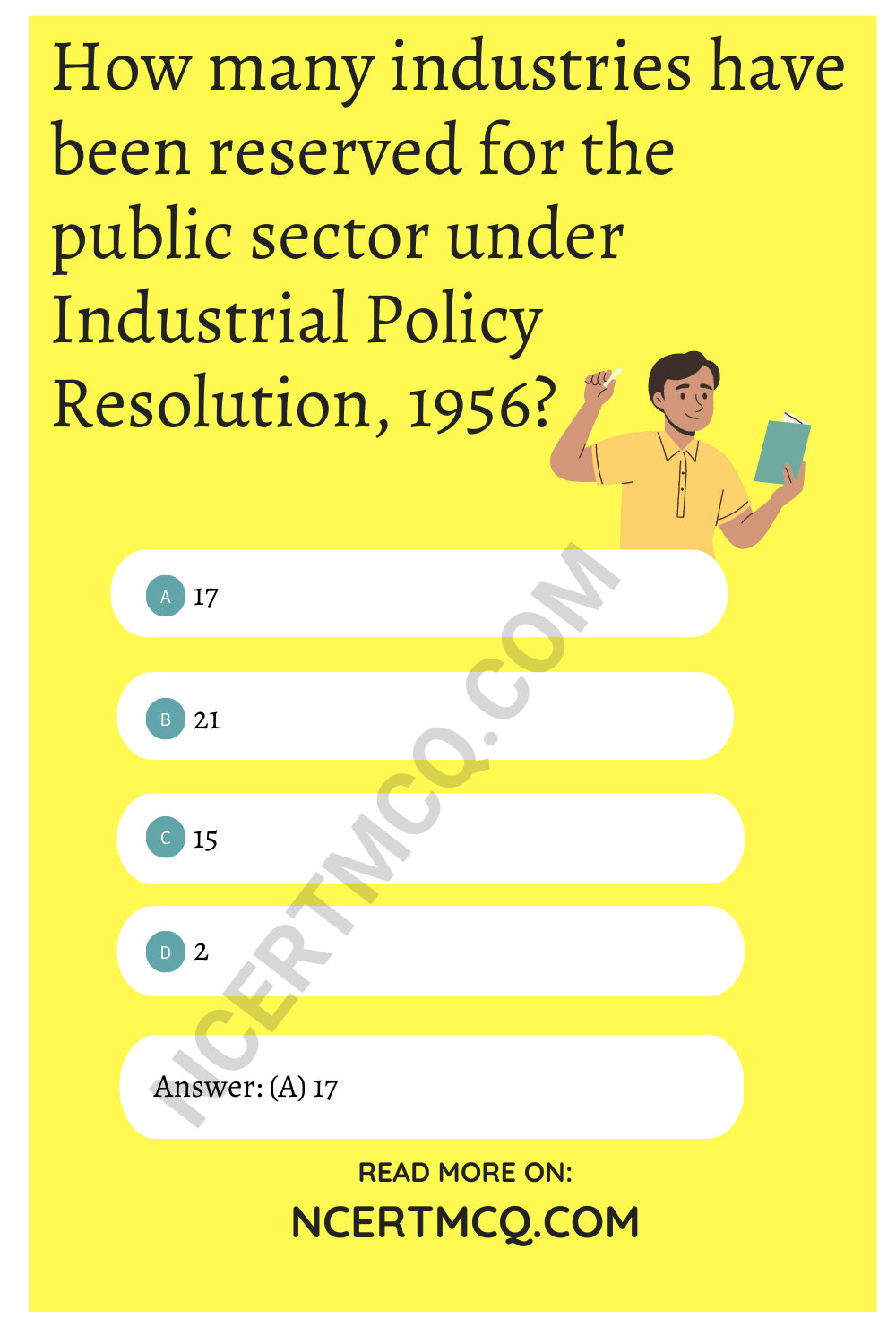Check the below NCERT MCQ Questions for Class 12 Economics Chapter 2 Indian Economy 1950-1990 with Answers Pdf free download. MCQ Questions for Class 12 Economics with Answers were prepared based on the latest exam pattern. We have provided Indian Economy 1950-1990 Class 12 Economics MCQs Questions with Answers to help students understand the concept very well.
Class 12 Economics Chapter 2 Indian Economy 1950-1990 MCQ With Answers
Economics Class 12 Chapter 2 MCQs On Indian Economy 1950-1990
I. Choose the correct alternative.
Indian Economy 1950 To 1990 Class 12 MCQ Question 1.
In which of the following type of economy are resources owned privately and the main objective behind economic activities is profit-making?
(A) Capitalist
(B) Socialist
(C) Mixed
(D) Global
Answer
Answer: (A) Capitalist

Indian Economy 1950 To 1990 MCQ Question 2.
Which of the following is the main objective of carrying out various economic activities?
(A) Profit
(B) Public welfare
(C) Competition
(D) Equality
Answer
Answer: (B) Public welfare
MCQ Of Indian Economy 1950 To 1990 Question 3.
When was the National Development Council (NDC) set up as an adjunct to the Planning Commission?
(A) 1950
(B) 1969
(C) 1952
(D) 1979
Answer
Answer: (C) 1952
Indian Economic Development Class 12 MCQ Chapter 2 Question 4.
Which of the following had been responsible for the heavy burden of the deal and its interest?
(A) BOP deficit
(B) BOP surplus
(C) Equilibrium
(D) None of these
Answer
Answer: (A) BOP deficit
Chapter 2 Indian Economy Class 12 MCQ Question 5.
Agriculture sector contributed _______ percent to the GDP in 1990-91.
(A) 24.6
(B) 34.9
(C) 40.5
(D) 59.0
Answer
Answer: (B) 34.9
Indian Economy 1950 To 1990 MCQ Questions Question 6.
What is needed to provide protection against natural calamities like floods, drought, locusts, thunderstorms, etc.?
(A) Multiple cropping
(B) Green revolution
(C) Crop insurance
(D) HYV
Answer
Answer: (C) Crop insurance
Ch 2 Indian Economy Class 12 MCQ Question 7.
Which of the following steps promoted the growth of the economy as a whole by stimulating the development of industrial and tertiary sectors?
(A) Independence
(B) Planning
(C) Colonial rule
(D) Green revolution
Answer
Answer: (B) Planning
MCQ On Indian Economy 1950 To 1990 Question 8.
How many industries have been reserved for the public sector under Industrial Policy Resolution, 1956?
(A) 17
(B) 21
(C) 15
(D) 2
Answer
Answer: (A) 17

II. Fill in the blanks with the correct answer.
MCQ Questions For Class 12 Economics Chapter 2 Question 1.
The percentage of the total population below the poverty line has ________ in India since independence.
Answer
Answer: declined
Indian Economy Chapter 2 MCQ Question 2.
_______ planning includes all spheres of economic and social activities.
Answer
Answer: Comprehensive
MCQ Of Chapter 2 Indian Economy Class 12 Question 3.
________ is the Chairman of the Planning Commission.
Answer
Answer: Prime Minister
Class 12 Indian Economy Chapter 2 MCQs Question 4.
________ economy is the framework of planning in India.
Answer
Answer: Mixed
Question 5.
Full employment and equitable distribution of income and wealth are the _______ period objectives of planning in India.
Answer
Answer: long
Question 6.
________ combined with social justice is the principal goal of planning in India.
Answer
Answer: Economic growth
Question 7.
Modernisation means adoption of new technology and a change in ________
Answer
Answer: social outlook
Question 8.
Planning in India started with a heavy reliance on the _______ sector.
Answer
Answer: Public
Question 9.
Land Reforms were introduced to make tillers the owners of the land and bring about _______ in agriculture.
Answer
Answer: equity
Question 10.
Import Substitution policy was introduced to protect ________ from foreign competition.
Answer
Answer: domestic industries
III. State whether the following statements are true or false.
Question 1.
In a capitalist economy, production takes place for selling the output in the market with profit as the primary motive.
Answer
Answer: True
Question 2.
Pt. Jawaharlal Nehru and many other leaders favoured capitalism for independent India.
Answer
Answer: False
Question 3.
President is the Chairman of the Planning Commission.
Answer
Answer: False
Question 4.
Pt. Jawaharlal Nehru is regarded as the architect of Indian planning.
Answer
Answer: False
Question 5.
Economic growth means equal opportunity to all and the removal of inequality in the distribution of income and wealth.
Answer
Answer: False
Question 6.
Land Reforms were introduced to make tillers the owners of the land.
Answer
Answer: True
Question 7.
The green revolution resulted in a marketable surplus of agricultural produce.
Answer
Answer: True
Question 8.
The private Sector comprises industries owned, controlled, and managed by the government with the aim of social welfare.
Answer
Answer: False
Question 9.
Under Industrial Policy Resolution (IPR), 1956, Category II of the industrial sector includes industries jointly owned and controlled by the private sector and the state.
Answer
Answer: True
Question 10.
Quotas are a tax on imported goods while tariffs specify the number of goods which can be imported.
Answer
Answer: False
IV. Match the following.
Question 1.
| Column-I | Column-II |
| 1. Demonetization | (A) 1950 |
| 2. Planning Commission | (B) 2015 |
| 3. NITI Aayog | (C) P. C. Mahalanobis |
| 4. First five-year plan | (D) 2016 |
| 5. Architect of Indian Planning | (E) 1967-68 |
| 6. Green Revolution | (F) 1951 |
| 7. Economic reforms in India | (G) Prime Minister |
| 8. Chairman of Planning Commission | (H) 2017 |
| 9. New Development Council | (I) 1991 |
| 10. GST | (J) 1952 |
Answer
Answer:
| Column-I | Column-II |
| 1. Demonetization | (D) 2016 |
| 2. Planning Commission | (A) 1950 |
| 3. NITI Aayog | (B) 2015 |
| 4. First five-year plan | (F) 1951 |
| 5. Architect of Indian Planning | (C) P. C. Mahalanobis |
| 6. Green Revolution | (E) 1967-68 |
| 7. Economic reforms in India | (I) 1991 |
| 8. Chairman of Planning Commission | (G) Prime Minister |
| 9. New Development Council | (J) 1952 |
| 10. GST | (H) 2017 |
We hope the given NCERT MCQ Questions for Class 12 Economics Chapter 2 Indian Economy 1950-1990 with Answers Pdf free download will help you. If you have any queries regarding CBSE Class 12 Economics Indian Economy 1950-1990 MCQs Multiple Choice Questions with Answers, drop a comment below and we will get back to you soon.
Class 12 Economics Indian Economic Development with Answers MCQ:
- Indian Economy on the Eve of Independence Class 12 MCQ
- Indian Economy 1950-1990 Class 12 MCQ Questions
- Liberalisation, Privatisation and Globalisation: An Appraisal Class 12 MCQ
- Poverty Class 12 MCQ
- Human Capital Formation in India Class 12 MCQ
- Rural Development Class 12 MCQ
- Employment: Growth, Informalisation and Other Issues Class 12 MCQ
- Infrastructure Class 12 MCQ
- Environment and Sustainable Development Class 12 MCQ
- Comparative Development Experiences of India and its Neighbours Class 12 MCQ
